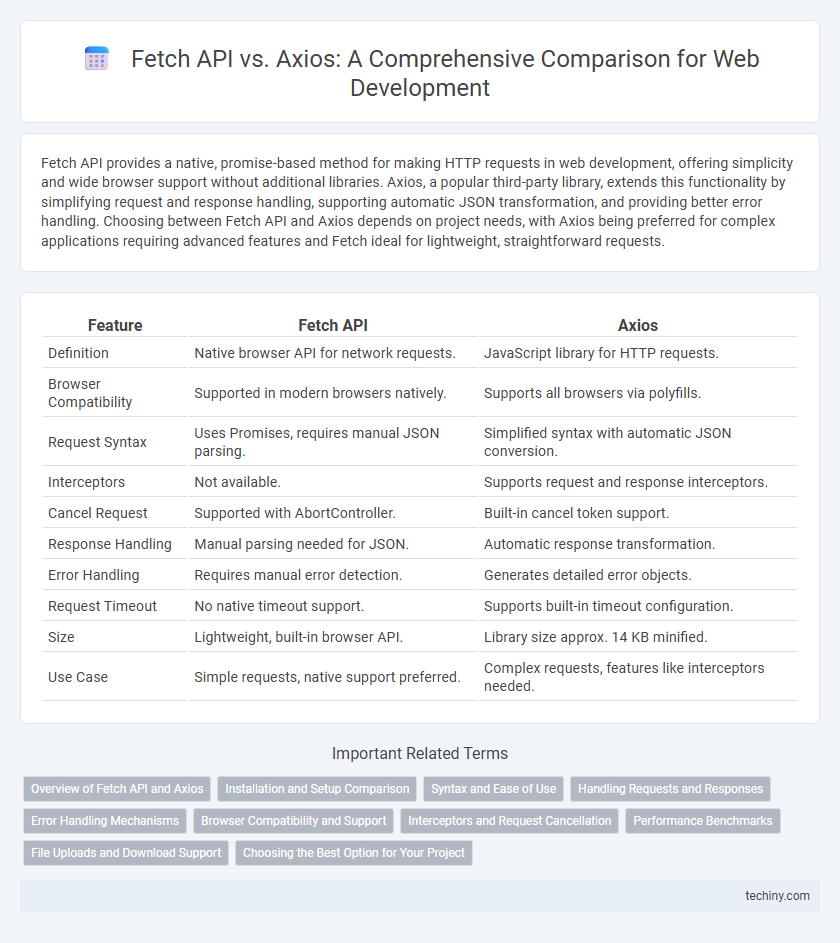Fetch API provides a native, promise-based method for making HTTP requests in web development, offering simplicity and wide browser support without additional libraries. Axios, a popular third-party library, extends this functionality by simplifying request and response handling, supporting automatic JSON transformation, and providing better error handling. Choosing between Fetch API and Axios depends on project needs, with Axios being preferred for complex applications requiring advanced features and Fetch ideal for lightweight, straightforward requests.
Table of Comparison
| Feature | Fetch API | Axios |
|---|---|---|
| Definition | Native browser API for network requests. | JavaScript library for HTTP requests. |
| Browser Compatibility | Supported in modern browsers natively. | Supports all browsers via polyfills. |
| Request Syntax | Uses Promises, requires manual JSON parsing. | Simplified syntax with automatic JSON conversion. |
| Interceptors | Not available. | Supports request and response interceptors. |
| Cancel Request | Supported with AbortController. | Built-in cancel token support. |
| Response Handling | Manual parsing needed for JSON. | Automatic response transformation. |
| Error Handling | Requires manual error detection. | Generates detailed error objects. |
| Request Timeout | No native timeout support. | Supports built-in timeout configuration. |
| Size | Lightweight, built-in browser API. | Library size approx. 14 KB minified. |
| Use Case | Simple requests, native support preferred. | Complex requests, features like interceptors needed. |
Overview of Fetch API and Axios
Fetch API is a native JavaScript interface that enables asynchronous HTTP requests, offering a modern, promise-based approach for fetching resources across the network. Axios is a popular third-party library built on promises that simplifies HTTP requests by providing features like automatic JSON data transformation, request cancellation, and interceptors. Both tools are widely used in web development for handling client-server communication efficiently.
Installation and Setup Comparison
Fetch API requires no installation or setup since it is built-in to modern browsers, allowing immediate use for HTTP requests. Axios, a popular third-party library, needs to be installed via npm or yarn with commands like `npm install axios`, making it necessary to manage dependencies in your project. While Fetch API offers a native, promise-based approach, Axios provides additional features out of the box, but requires initial setup steps before integration.
Syntax and Ease of Use
Fetch API offers a straightforward, native syntax using promises for making HTTP requests, with methods like fetch(url).then(response => response.json()). In contrast, Axios simplifies the process with a cleaner syntax and built-in features such as automatic JSON parsing, request cancellation, and interceptors, using axios.get(url).then(response => response.data). Developers often prefer Axios for its concise and easier-to-read code, especially in complex applications requiring advanced request management.
Handling Requests and Responses
Fetch API provides a built-in, promise-based method for handling HTTP requests and responses with a straightforward syntax, but requires manual response parsing like converting JSON. Axios simplifies handling requests and responses by automatically transforming JSON data and supports features such as request cancellation, interceptors, and automatic timeouts that enhance error handling and control. Both tools facilitate asynchronous operations in web development, but Axios offers a more robust and user-friendly approach for managing complex request and response workflows.
Error Handling Mechanisms
Fetch API requires manual checking of HTTP response status and explicitly throwing errors to handle failures, which can lead to overlooked errors if not carefully implemented. Axios automatically rejects promises for HTTP status codes outside the 2xx range, simplifying error detection and offering unified error objects with detailed information such as request, response, and configuration. This built-in error handling mechanism in Axios reduces boilerplate code and improves reliability when managing API request errors in web development.
Browser Compatibility and Support
Fetch API enjoys broad native support across all modern browsers including Chrome, Firefox, Safari, Edge, and Opera, making it a reliable choice for straightforward HTTP requests without additional dependencies. Axios, a popular third-party library, offers enhanced browser compatibility by supporting older browsers like Internet Explorer 11 through polyfills, ensuring consistent behavior in legacy environments. Developers prioritizing seamless integration with older browsers often prefer Axios for its widespread support and built-in features that simplify error handling and request configuration.
Interceptors and Request Cancellation
Fetch API lacks native support for interceptors, making it challenging to modify or log requests and responses without additional wrapper code, whereas Axios provides built-in request and response interceptors that simplify such tasks. Axios also offers straightforward request cancellation through CancelToken or AbortController integration, while Fetch API uses the AbortController interface for aborting fetch requests but requires more manual setup. Developers often prefer Axios for advanced request handling and cancellation features due to its ease of use and built-in support.
Performance Benchmarks
Fetch API offers faster native performance with lower overhead since it is built into modern browsers without extra dependencies. Axios provides enhanced functionality like automatic JSON transformation and request cancellation but introduces slight latency due to its library size. Performance benchmarks consistently show Fetch API has better load times and reduced memory usage compared to Axios in typical web development scenarios.
File Uploads and Download Support
Fetch API provides native support for file uploads using FormData, enabling straightforward handling of multipart/form-data, while its native support for file downloads requires custom handling with Blob objects and URL.createObjectURL. Axios simplifies both file uploads and downloads by automatically setting appropriate headers and offering built-in progress event handlers, enhancing user feedback during data transfer. Compared to Fetch, Axios offers more convenient and concise code patterns for managing file operations, making it a preferred choice in complex web applications requiring robust file upload and download workflows.
Choosing the Best Option for Your Project
Fetch API offers a built-in, promise-based solution with native browser support, making it lightweight and ideal for simple GET requests. Axios provides advanced features like automatic JSON transformation, request cancellation, and interceptors, enhancing flexibility for complex applications. Choose Fetch for minimal dependencies and Axios when you need robust features and cross-browser consistency in your web development project.
Fetch API vs Axios Infographic

 techiny.com
techiny.com